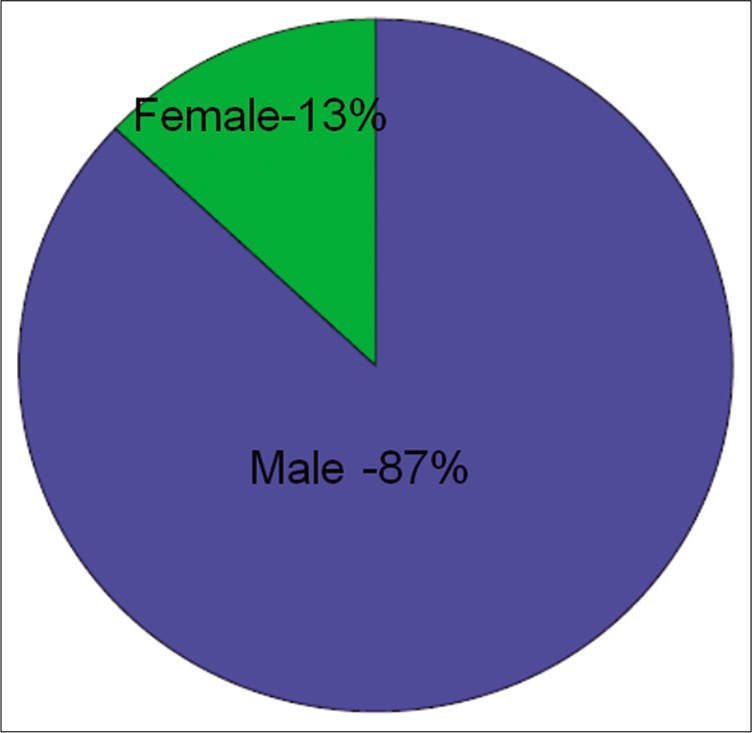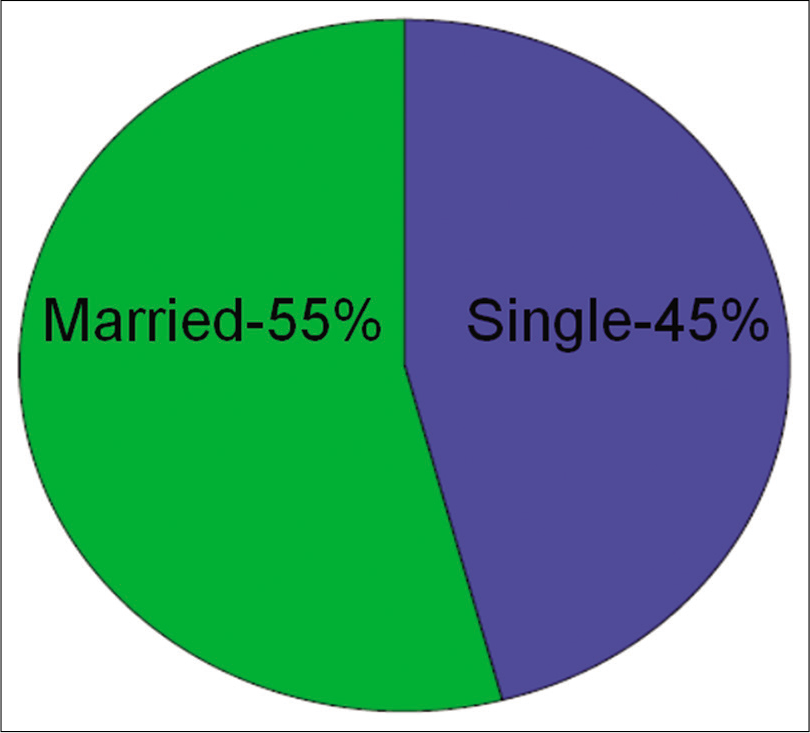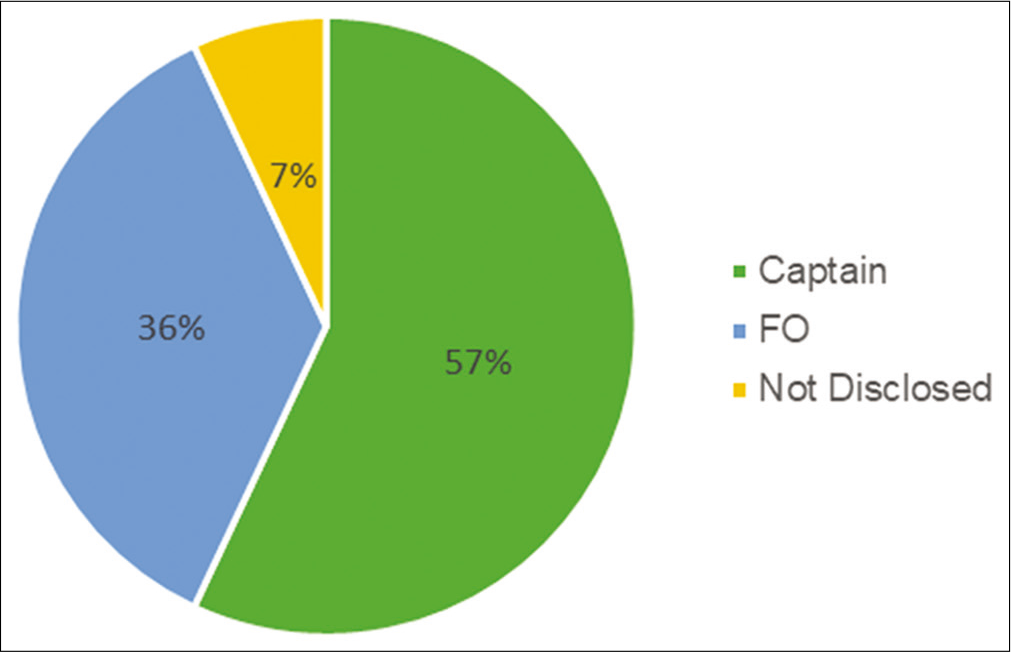Translate this page into:
An appraisal of happiness in civil aircrew

*Corresponding author: Dr Divya N, MBBS, MD (Aerospace Medicine) SMC, Air Force Station, Chabua, Assam, India. drdivya.n22@gmail.com
-
Received: ,
Accepted: ,
How to cite this article: Narayanappa D, Sowgandhi CN, Tripathy NK, Agarwal A. An appraisal of happiness in civil aircrew. Indian J Aerosp Med 2020;64(1):23-6.
Abstract
Introduction:
Commercial aviation is a unique occupation, where the professional responsibility to ensure the safety of the aircraft and its occupants lies with the pilot, making civil aviation a stressful and demanding job. Psychological fitness plays a crucial role in helping aircrew adapt to and deal with these occupational demands. In the past few years, the awareness and interest in mental health among civil aviators and the aviation industry have been on the rise. Happiness is characterized as a lasting state with positive emotions and life satisfaction. It is known to improve performance and reduce stress. Based on this, the main objective of this study was to conduct a survey to appreciate the level of happiness among civil aircrew.
Material and Methods:
A widely used scale for assessment of happiness called Oxford Happiness Questionnaire (OHQ) was administered to both male and female civil aircrew (n = 100). OHQ is a 29-item self-reporting questionnaire. Internal consistency was calculated using Cronbach’s alpha which was found to be 0.97 on the current sample. Data collected were also studied to find a correlation between demographic variables and happiness index.
Results:
A mean score of 4.87 was obtained in the OHQ which indicated that the civil aircrew perceived themselves to be quite happy. No significant relationship was found between age, experience, marital status, and happiness scores.
Conclusion:
This was a unique survey in which civil pilots flying both domestic and international flights from India were assessed in terms of their happiness level as a measure of psychological well-being. The participants consisted of a total of 100 aircrew, consisting of 87 males and 13 females. The happiness index in this sample was found to be moderate to high. Most of them perceived their lives and work to be meaningful, which led to high motivation and increased performance. The results also revealed that flying hours of civil aircrew had no significant relationship to happiness level, further indicating that age and experience of the pilots did not predict their happiness, which was akin to a number of researches conducted on the general population. Although the aircrew were found to be moderately happy, the happiness level could still be increased. Small and modest actions by both the aircrew and the airline industry may make a big difference to the happiness state of aircrew.
Keywords
Happiness index
Civil aircrew
Flight safety
INTRODUCTION
In commercial aviation, the aircrew are directly responsible for aerospace and passenger safety, making it a demanding job. To ensure optimal performance, aircrew receive intense and rigorous training and are expected to maintain a high level of health standards, making them a unique occupational group, faced with unique challenges. The demands of civil aviation can lead to increasing stress levels, which, in turn, could lead to psychological disorders. Psychological problems among aircrew not only impact well-being but also aerospace safety and task performance. These may range from minor transient stress to persistent personality and lifestyle problems with potentially serious consequences to flight safety.[1]
The 2015 Germanwings Flight 9525 accident has revealed the significance of mental health problems among aircrew as the copilot had a history of psychotic depression. Other similar and parallel cases have also been reported.[2] Post the Germanwings incident, numerous studies have been conducted to evaluate the prevalence of psychological disorders among commercial aircrew. A study by Feijó et al. investigated “Common Mental Disorders (CMD)” among pilots in Brazil. They found that 23.7% of participating pilots with a heavy workload had potential CMD.[3]
Assessment of mental health dysfunction is important. However, an alternative approach is to assess well-being and develop it further for a more fulfilling personal, and occupational life.[4] The World Health Organization defines health as not merely the absence of disease or infirmity, but a state of complete physical, mental, and social well-being. Happiness and related well-being factors also act as protective factors against depression, anxiety, and suicide.
Martin Seligman defines well-being as having positive emotions, engagement, good relationships, meaning in life, and accomplishments.[5] The most researched variable among these is happiness. Theoretically, happiness is variably understood as affective happiness (bottom-up) and cognitive happiness (top-down). According to the bottom-up approach, happiness is assessed as a total sum of aggregated positive and negative feelings. The top-down approach recommends that happiness is largely a product of an individual’s cognition and refers to subjective evaluations of one’s understandings and expressions of life satisfaction.[6] Lyubomirsky et al. have suggested that happiness is 50% genetically determined (top-down), 10% environmentally caused, and 40% potentially modifiable by intentional happiness-enhancing activities and practices (bottom-up).[7,8] The type of occupation, physical activity, and place of residence of individuals are found to be linked to their happiness scores. Studies have shown that athletes of team sports feel happier, more relaxed, and have low risk of depression and anxiety.[9] Working conditions impact happiness through perceptions of the quality of working and non-working life. Working condition’s happiness varies with the characteristics of the person or the environment. Such changes consist of short-term effects of work (e.g., mood, energy level, and interests) and long-term effects of work (e.g., skills, personality, and health).
With this background, this exploratory study was conducted in the form of a descriptive survey in Indian commercial aircrew with the aim to assess their level of happiness as a prelude to the psychological well-being. In addition, the study also aimed to find if the occupation, namely flying, had any relation to happiness.
MATERIAL AND METHODS
Participants
A total of 100 aircrew reporting at the Institute of Aerospace Medicine participated in this study. Aircrew with a commercial pilot license and airline transport license flying both domestic and international sectors were included. Foreign aircrew temporary authorization pilots, commercial pilot aspirants applying for student pilot license, and civil aircrew with medical disabilities were excluded from the study.
Tools
Oxford Happiness Questionnaire (OHQ)
The OHQ was developed by psychologists Michael Argyle and Peter Hills at Oxford University (2002). It consists of 29 items with a six-point Likert scale response pattern from strongly disagree = 1 to strongly agree = 6, with the higher scores corresponding to higher levels of happiness. There are 12 negatively worded items that require reverse coding before calculating the total happiness score which is a sum of individual item scores. Examples of positively worded items include “I am very happy” and negatively worded items “I rarely wake up feeling rested.” According to the authors (2002), OHQ is supposed to measure personal happiness as a broader uni-dimensional construct, well-being, and aspects of sustainability and resilience. In addition, it is also reported to have good internal consistency, with the Cronbach’s alpha at the level of 0.90 and above.[10] The internal consistency in this study was calculated using Cronbach’s alpha which was found to be 0.97, indicating very high internal consistency.
Data collection and scoring
Informed consent was taken from the participants and confidentiality ensured. Each aircrew was asked to fill in the required demographic details as well. They were advised to read each item carefully and answer honestly. Each questionnaire was then carefully scored by the investigators. First, items marked (R) were scored in reverse, i.e., 1 changed to 6, 2 changed to a 5, 3 changed to 4, and so on. Then, all the responses for the 29 questions were added. The total was divided by 29 to obtain the total happiness score.
Analysis
The data were compiled and analyzed using the SPSS statistical package V 23. Descriptive statistics for age, rank, gender, and marital status were calculated. The mean happiness index was calculated for the whole sample. Pearson product-moment correlation was carried out to find a relationship between happiness level and flying hours, as flying hours are positively correlated with age and experience. A t-test was used to find if a difference existed between the happiness scores of single and married aircrew.
RESULTS
Table 1 indicates the age and experience of the study group. The analysis revealed that the mean age of the study group was 36.72 years with an average of 5415 flying hours. Of the 100 aircrew, 87% were male and 13% were female, as depicted in Figure 1. Among the 100 aircrew, 45% were single and 53% were married, as depicted in Figure 2. Among them, 57% were captain’s, 36% were first officers and 7% did not disclose their role, as depicted in Figure 3.
| Parameter | Mean | Standard deviation | Range |
|---|---|---|---|
| Age | 36.72 year | 11.547 year | 22–64 year |
| Flying hours | 5415.12 h | 5713 h | 0–23,377 h |

- Pie chart showing gender distribution.

- Pie chart showing marital status distribution.

- Pie chart showing rank distribution.
On the OHQ, the overall happiness index on the sample was found to be 4.87, indicating a moderate to a high level of happiness. The Pearson product-moment correlation between the happiness score and flying hours was found to be 0.09, which was not statistically significant (P=0.371). The t-test revealed that with equal variance assumed (Levene’s F = 0.937 and Sig. = 0.335), no significant difference (P=0.657) existed between the happiness scores of single and married aircrew. The Pearson product-moment correlation between the happiness score and age was found to be 0.08 with P = 0.462, which was not significant.
DISCUSSION
The present study intended to explore the happiness levels of the civil aviation pilots flying both domestic and international flights from India as a measure of psychological well-being. The participants consisted of a total of 100 aircrew, of which 87 were male and 13 were female. More than half of them were married, and 57% of them were Captains. Certain aircrew were not employed in any airline, resulting in the large variation in the range of flying hours. The study found that the happiness level in the sample as a whole was moderate to high. This indicates that they tend to be pleased with the way they are, and have a positive outlook towards their past, present and future. In addition, they are interested in people around them and experience a range of positive emotions quite frequently. They mostly find their lives and their work to be meaningful, which can lead to high motivation and increased performance.
It was found that the quantum of flying hours had no significant relationship to happiness level, indicating that age and experience of the pilots did not predict their happiness. Similar observations have been made in studies conducted on the general population.[11] There can be a number of different personal, interpersonal, and socioeconomic variables that modulate the happiness levels in aircrew, of which age, experience, and marital status were analyzed in this study. No significant relationship was found between any of the variables and happiness scores, indicating that in this sample, younger aircrew were as happy as the older aircrew and that marital status did not predict any changes in the happiness scores. Such an observation does not corroborate with studies carried out in general population which shows that marriage is often related to increased happiness in both males and females alike.[12] The major observation in the present study revealed that our sample of civil aircrew were moderate to very happy as per the OHQ, a fact that was not affected by age and other important demographic factors. Although the happiness score of the civil aircrew was found to be high, proactive measures should always be followed to enhance further happiness and psychological well-being. It is our considered belief that this proactive approach would lead to improved well-being and life satisfaction, as well as an increase in motivation and performance. We further believe that the assessment of happiness and related well-being variables should become a vital part of aircrew mental health examinations. Airline industry and aeromedical examiners need to be sensitized on the assessment of the mental health of the aircrew.
To the best of our knowledge, this study is the first of its kind in the Indian civil aviation sector. It not only fills a gap in knowledge and literature about mental health in civil aircrew but also paves a path for a more holistic perspective of mental health, focusing on positive psychology.
As the aim was to provide a measure of happiness level in civil aircrew, the moderators of happiness were not investigated, as that was beyond the scope of this study.
CONCLUSION
This descriptive survey aims to fill an important gap of knowledge by providing a current glimpse of mental health among commercial airline pilots, which, to date, had not been available. It reveals that they are quite happy with themselves and their environment and that age, experience, and marital status of the aircrew do not affect their happiness levels.
This study opens the door for a number of future studies that may focus on the effects of different moderators on happiness levels in civil aircrew which were not included in this study. Furthermore, research on various positive psychology aspects which are known to have a direct bearing on happiness and relevant to the present study population can be undertaken.
Declaration of patient consent
The authors certify that they have obtained all appropriate consent from the participants.
Financial support and sponsorship
Nil.
Conflicts of interest
NK Tripathy is the editor of this journal. He does not have any competing interests.
References
- Aviation and Aerospace Psychology: Pilot Mental Health and Wellbeing UK: The British Psychological Society; 2017.
- [Google Scholar]
- Reflecting on the Germanwings disaster: A systematic review of depression and suicide in commercial airline pilots. Front Psychiatry. 2018;9:86.
- [CrossRef] [PubMed] [Google Scholar]
- Common mental disorders among civil aviation pilots. Aviat Space Environ Med. 2012;83:509-13.
- [CrossRef] [PubMed] [Google Scholar]
- Health benefits: Meta-analytically determining the impact of well-being on objective health outcomes. Health Psychol Rev. 2207;1:83-136.
- [CrossRef] [Google Scholar]
- Doing the right thing: Measuring wellbeing for public policy. Int J Well Being. 2011;1:79-106.
- [Google Scholar]
- Exploring constructs of well-being, happiness and quality of life. PeerJ. 2018;6:e4903.
- [CrossRef] [PubMed] [Google Scholar]
- Becoming happier takes both a will and a proper way: An experimental longitudinal intervention to boost well-being. Emotion. 2011;11:391-402.
- [CrossRef] [PubMed] [Google Scholar]
- Organizational virtuousness and work engagement: Mediating role of happiness in India. Adv Dev Hum Resour. 2018;20:88-102.
- [CrossRef] [Google Scholar]
- Impact of sport types on happiness of university athletes. J Phys Educ. 2016;3:91-100.
- [Google Scholar]
- The oxford happiness questionnaire: Transformation from an ordinal to an interval measure using rasch analysis. J Happiness Stud. 2016;17:15-35.
- [Google Scholar]
- Happiness across age groups: Results from the 2007 national psychiatric morbidity survey. Int J Geriatr Psychiatry. 2010;26:608-14.
- [CrossRef] [PubMed] [Google Scholar]
- Marital status and happiness: A 17-nation study. J Marriage Fam. 1998;60:527-36.
- [CrossRef] [Google Scholar]






